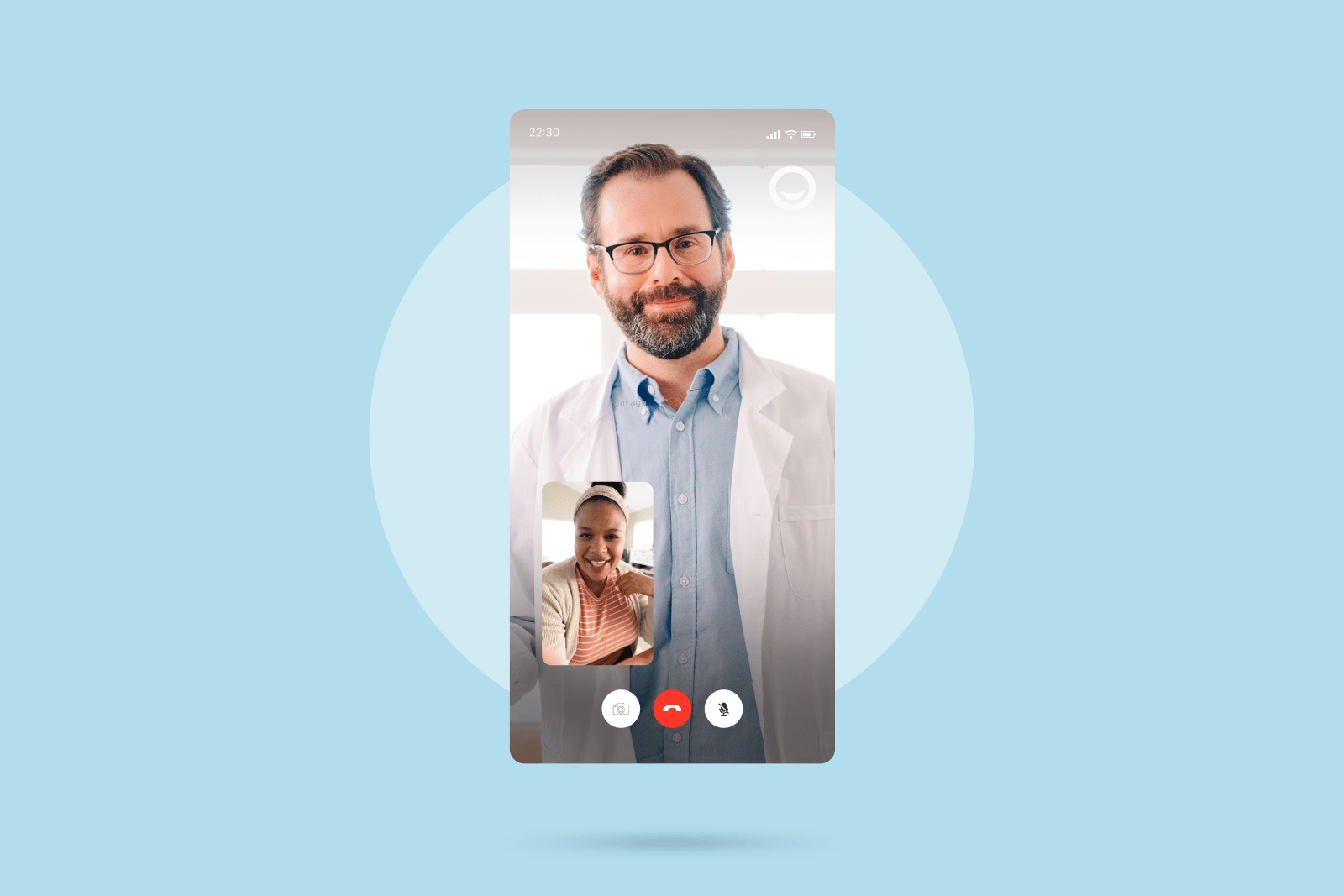
Impetigo treatment online today
In order to treat your impetigo, consult with one of our board-certified primary care doctors online today to develop a treatment plan to get relief from skin sores. Get a new prescription to treat impetigo or refill an existing prescription today.*

*Prescriptions are provided at the doctor's discretion. Learn more about our controlled substances policy and how to save up to 80% with our prescription discount card. PlushCare doctors cannot diagnose or treat all cases of impetigo. Our primary care physicians can conduct an initial evaluation of your symptoms but may need to refer you to a specialist or for in-person diagnosis or treatment. If you are experiencing life-threatening symptoms, seek emergency medical attention immediately.
Learn about impetigo
Although impetigo is a common skin infection among children, it can be easily treated with antibiotics. Antibiotic treatment can also help protect others from developing an infection.
Impetigo can be classified as either primary impetigo or secondary impetigo. Primary impetigo happens when previously healthy skin becomes infected by bacteria. Meanwhile, secondary impetigo happens when an infection forms at a previous wound site.
Impetigo causes
You might be exposed to Staphylococcus aureus bacteria if you come into direct contact with someone infected or with items they've touched, such as clothing, towels, or toys.
Impetigo symptoms
Impetigo can affect any part of the body, but it commonly occurs around the nose, lips, mouth, hands, and forearms. In infants and younger children, bacterial infections can also affect the diaper area. There are three types of impetigo, each with slightly different symptoms:
Non-bullous impetigo
Non-bullous impetigo, which involves crusted sores, is the most common type of impetigo. It begins as small blisters, which eventually burst and leave small patches of red skin. Over the course of a week, a honey-colored crust covers the area. Over a week, a honey-colored crust covers the area.
Bullous impetigo
With bullous impetigo, large fluid-containing blisters develop around the affected area. These blisters often appear clear, then cloudy. They often stay on the skin longer before bursting.
Ecthyma
Ecthyma impetigo appears as "punched out" ulcers with yellow crusty patches and red edges.
How to treat impetigo
Because impetigo is caused by a bacterial infection, doctors typically prescribe antibiotics to treat impetigo. If you only have a few affected spots that don't penetrate deeply into your skin, your doctor may prescribe an antibiotic cream or ointment to apply to the area.
If you have a more severe infection, your doctor will likely prescribe oral antibiotics. Your healthcare provider may prescribe an antibiotic based on the type of bacteria that caused your skin infection. It's important to take your antibiotics as prescribed until you finish treatment, even if your infection goes away. Your healthcare provider may also provide instructions to follow during treatment, such as:
-
Keep crusty patches clean with soap and warm water.
-
Wash your hands often with soap and warm water.
-
Cover the affected area with gauze bandages to keep patches dry and avoid spreading the infection to other exposed areas.
-
Wear loose clothing to avoid irritating skin infections.
Impetigo medication
How to prevent impetigo
Impetigo can easily spread through direct skin-to-skin contact. You can lower your risk of developing impetigo by taking precautionary measures. For example:
-
Always wash your skin with soap and warm water if you come into contact with an infected person.
-
Don't share personal items, such as bed linens, towels, and hair combs.
-
Wash your towels, bed linens, and clothes in hot water.
-
Wash your hands with soap and warm water after handling tissues that might contain germs.
-
Sneeze into your elbow (not your hands) to avoid spreading germs to other people.
-
Keep cuts, scratches, and insect bites clean, and cover broken skin with gauze bandages.
Young children should wash their hands frequently and bathe regularly to lower their risk of skin infections. In addition, parents should pay special attention to injuries (cuts, insect bites, scrapes, etc.), rashes, red sores, and any other skin conditions.
When to see a doctor for impetigo
If you're already receiving treatment for impetigo, monitor your sores. Be sure to call your doctor if your skin doesn't start healing after 3 days of treatment or if a fever develops.
If the area around your skin infection becomes red, warm, or tender to the touch, seek immediate medical attention.
Impetigo treatment FAQs
What are the symptoms of impetigo?
For most people, a rash starts in a single spot, but it may spread to other areas of the body. The rash may be slightly painful or itchy.
What causes impetigo?
Many people have staph or strep bacteria on their body from time to time. Some people may have lifelong (permanent) colonies of bacteria on their skin. These bacteria may grow inside your nose, throat, hands, or other areas of the body.
When staph or strep bacteria are on top of healthy skin, they don't cause problems, symptoms, or skin infections. However, a small break in the skin allows the bacteria to enter, leading to an infection.
Who is at risk of impetigo?
People who have staph or strep bacteria on their skin are more likely to catch impetigo. In particular, children aged 2–5 are most likely to catch impetigo due to poor hygiene habits, contact with infected friends, and touching infected items.
You may also catch impetigo if you have a health condition or skin condition, such as:
-
Atopic dermatitis (eczema)
-
Insect bites
-
Diabetes
-
Liver problems
-
HIV/AIDs infection
-
Skin sores (for example, from a scabies infection)
-
Immune deficiencies
You may face an increased risk of impetigo if you live or work somewhere where people are in close contact, such as a dorm, prison, or barrack. You're more likely to develop impetigo if you've been in contact with someone colonized with the bacteria.
Where is impetigo common?
The most common places of impetigo infections include Oceania, Australia, and New Zealand. In many cases, impetigo is seasonal, as the strep and staph bacteria responsible for impetigo skin infections tend to thrive in warm, wet, and humid conditions.
According to the CDC, "impetigo is more common in areas with hot, humid summers and mild winters (subtropics), or wet and dry seasons (tropics)." However, impetigo can occur anywhere.
Impetigo also spreads where groups of people gather. For example, if someone has impetigo, it often spreads to other people in the same household. Crowded conditions, such as elementary schools and daycares, can increase the risk of impetigo.
Can I get impetigo treatment over the counter?
Our board-certified physicians are available 24/7 for telehealth appointments to give you a diagnosis, treatment options, and to send an online prescription directly to your pharmacy. Appointment are available with or without insurance, and we accept most major plans.
3 simple steps to request treatment for impetigo today

Book an impetigo treatment appointment.

Talk to your medical provider regarding your impetigo symptoms.

Pick up a prescription to treat your impetigo, if provided
Related conditions to impetigo
Impetigo treatment pricing details
To request impetigo treatment and get a new or refill on your prescription, join our monthly membership and get discounted visits.
30 days of free membership
- Same-day appointments 7 days a week
- Unlimited messages with your Care Team
- Prescription discount card to save up to 80%
- Exclusive discounts on lab tests
- Free memberships for your family
- Cancel anytime
Paying with insurance
Membership
$19.99 /month
First month free
Visits
Copay
Visit price with insurance
Often the same as an office visit. Most patients with in-network insurance pay $30 or less!
We accept these insurance plans and many more:



Paying without insurance
Membership
$19.99 /month
First month free
Visits
$129
Visit price without insurance
Impetigo treatment resources
Sources:
PlushCare is dedicated to providing you with accurate and trustworthy health information.
-
Centers for Disease Control and Prevention.About Impetigo. Accessed on June 18, 2024. https://www.cdc.gov/group-a-strep/about/impetigo.html?CDC_AAref_Val=https://www.cdc.gov/groupastrep/diseases-public/impetigo.html
-
Cedars-Sinai. Impetigo. Accessed on July 22, 2022. https://www.cedars-sinai.org/health-library/diseases-and-conditions/i/impetigo.html
-
Cleveland Clinic. Impetigo. Accessed on July 22, 2022. https://my.clevelandclinic.org/health/diseases/15134-impetigo
-
Mayo Clinic. Impetigo. Accessed on July 22, 2022. https://www.mayoclinic.org/diseases-conditions/impetigo/symptoms-causes/syc-20352352
PlushCare content is reviewed by MDs, PhDs, NPs, nutritionists, and other healthcare professionals. Learn more about our editorial standards and meet the medical team. The PlushCare site or any linked materials are not intended and should not be construed as medical advice, nor is the information a substitute for professional medical expertise or treatment.